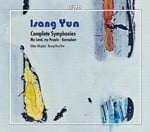4(III,IV=picc).4(IV=corA).4(IV=bcl).4(IV=dbn)-6.4.3.1-timp.perc(min.3):5susp.cym/glsp/tamb/2tgl/2maracas/SD/xyl/5tom-t/5tpl.bl/5gongs/BD/vib/2tam-t-harp-strings
Abbreviations (PDF)
Bote & Bock
Yun’s Symphony I was inspired by the peace movement, which opposed the stationing of nuclear rockets (cruise missiles and Pershing missiles) in the Federal Republic of Germany and the confrontation of the Western capitalist bloc and the Eastern communist bloc. The largest mass movement in the history of the Federal Republic culminated in the autumn of 1983 when almost a million people went out on the streets for four parallel major demonstrations in response to the Bundestag debate about the stationing of the rockets. In view of the threat to peace posed by the irresponsible use of nuclear energy, Yun understood his Symphony I as an admonition and an appeal. The four-movement work was composed in 1982-83 during about eight months of work for the hundredth-anniversary year of the Berlin Philharmonic Orchestra and premiered in the Berlin Philharmonic Hall under Reinhard Peters on May 15, 1984.
Symphony I opened a new phase of composition for Yun. In »tone-color compositions« like Bara (1960), Loyang (1962), Réak (1966), and Dimensions (1971), this Korean composer residing in Europe had established his ties to the Western European avant-garde. Then his quest for intelligibility gave rise to a series of solo concerti. He dealt with the trauma of his imprisonment in South Korea in his Cello Concerto (1975/76) and regarded his Flute Concerto (1977), a work inspired by a Buddhist fairy tale, as a parable of the futility of all human activity. Yun returns to his »tone-color-composition period« in the symphony, albeit in a different form and with a greater concreteness of content. European structuring principles allow for a clearer communication of content, and here the composer draws on the experience he had gathered while writing his solo concerti. If his »tone-color compositions« involved continuously flowing planes of similar and contrasting shape and his solo concerti the confrontation of solo instrument and and orchestra, now Yun obtains his oppositions from the orchestral sections themselves.
Yun's »main tones« not only unfold in a horizontal process but also appear in a vertical texture. Thus the b flat tone of the horn introduction in the first movement can be said to fold out to the chord of e flat – g flat (f sharp) – a – b (measure 13). A melodic stamp bearing the traces of cantabile clarity is the reverse side of a quality of harmonic modulation tending toward tones in third layers and blurred by additional, dissonant tones.
The dominant brass sound is enough to lend apocalyptic traces to the turbulent contrasts of the first movement. The purposeful forward motion of this structure of elemental force also leaves its mark on the traditional sequence of exposition, development, and recapitulation. The distressed startlement in the tonal gestures of the strings is placed in contrasting juxtaposition to the decisive unison of the six horns. The second musical thought is a theme reminiscent of the brokenness of Mahler or Shostakovich. The deep strings imitate the movement of surprised turning away, and in contrast the high strings offer a declamation in the form of an appellative-affirmative theme of major third and fifth intervals. Other elements of brightening include the tone bridges of the woodwinds at the beginning of the second section and in the recapitulation the iridescent texture of glissando and trilled string strands with woodwind figurations and their harp accompaniment.
Yun develops the second movement from a quiet peacefulness. While we survey a ravaged earth, mourning changes into a vision of beauty. The fully expressive, gliding ascent of the violins is typical. The third movement is a grotesque scherzo, and the trio with English horn and violin solos is a source of tranquillity in the brass finale.
In the fourth movement Yun sums up the previously expounded material. The ascent of fourth, tritone, and fifth intervals encountered in the first movement and – as a negating descent – in the scherzo has an integrating effect. Yun begins by establishing links to the initial horn introduction. The polar opposites of the high strings and the horns are each propelled upward twice in succession but founder because they alone cannot maintain the equilibrium. After a nocturnal interlude verging on complete standstill the woodwinds come to the rescue. Borrowing from the second movement, Yun summons up all the resources of his instrumental rhetoric in order to attain to the A of the absolute. The orchestra, however, only makes it as far as G sharp. The fourth and final phase is characterized by the bearing of the ascending fifth: woodwinds and high strings, along with the grimacing counterpoint of the trombones, share the perfect fifth (e – b). Then the horns close up with the diminished fifth (e – b flat). The trumpets, for Yun representing the voice of heavenly admonition, continue the tonal flow.
Walter-Wolfgang Sparrer (1986, translated by Susan Marie Praeder)

Filharmonia Pomorska Bydgoszcz / Takao Ukigaya
CPO 999 165-2
